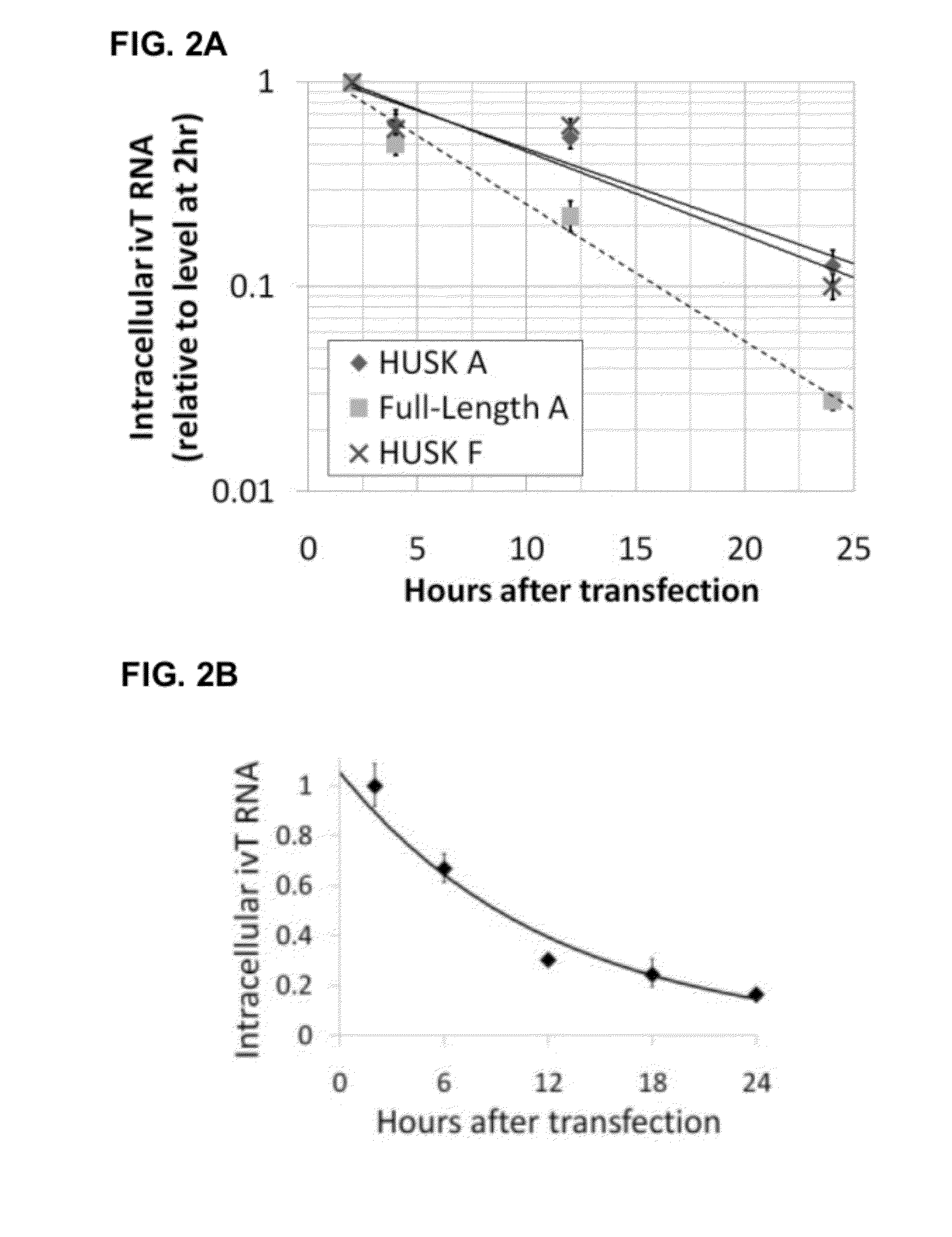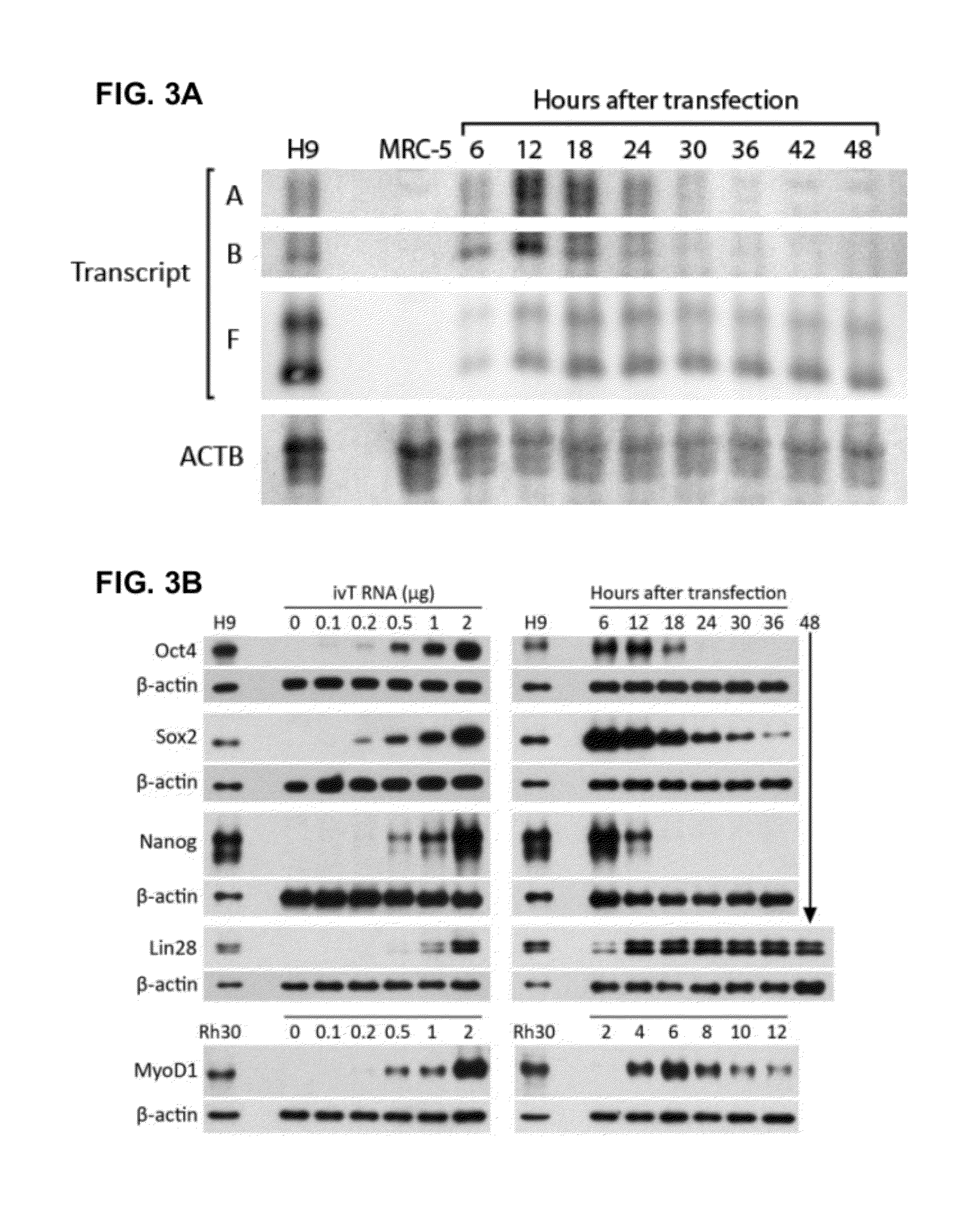Innate immune suppression enables repeated delivery of long RNA molecules
- Summary
- Abstract
- Description
- Claims
- Application Information
AI Technical Summary
Benefits of technology
Problems solved by technology
Method used
Image
Examples
example 1
Materials and Methods
[0188]Mouse embryonic fibroblast (MEF) derivation. Mouse embryonic fibroblasts were derived from E13 CF-1 mice (Charles River Laboratories). Animals were administered 250 mg / kg Avertin® (2,2,2-tribromoethanol) by interperitoneal injection, and euthanized by cervical dislocation. Uterine horns from each animal were removed from the peritoneum, placed in a 10 cm Petri dish and rinsed with PBS. Embryonic sacs were cut, and embryos removed, rinsed with PBS, and counted. Visceral tissue was separated and discarded, and embryos were rinsed again with PBS. Remaining tissue was minced with dissecting scissors, 2 mL trypsin was added, and tissue was further minced until no large pieces remained. An additional 5 mL trypsin was added, and dishes were placed in a 37 C, 5% CO2 incubator for 20-30 minutes. MEF Media media (see Appendix C) supplemented with penicillin and streptomycin was added, and cells were cultured in T75 flasks (approximately 3 embryos per flask). The fol...
example 2
A. ivT-Template Assembly and In Vitro Transcription
[0197]Recombinant T7 bacteriophage RNA polymerase is widely used for in vitro transcription from a DNA template containing the minimal T7 promoter sequence, TAATACGACTCACTATAGGG (SEQ ID NO: 22), with the last three bases (GGG) encoding the first three nucleotides of the transcript (also GGG). Several commercial in vitro-transcription kits are available that use this enzyme together with buffers and additives designed to produce high yields of full-length transcripts. Linearized plasmids, PCR products, and single-stranded oligonucleotides can be used as T7 RNA-polymerase templates, although the T7 promoter must be double-stranded. For this study, to simplify the template synthesis procedure while minimizing sequence errors, the in vitro-transcription template was designed as a blunt-ended PCR product to be produced by a high-fidelity DNA polymerase from reverse-transcribed poly(A)+ mRNA. Choosing a PCR product facilitates the product...
example 3
siRNA Knockdown of IFNB1 Expression
[0210]siRNA targeting IFNB1 was used to knock down its expression in order to suppress the innate immune response. The siRNA was delivered to MRC-5 fibroblasts by electroporation, with or without ivT-RNA. Mock-transfected cells that received no siRNA exhibited a 10,000-fold over expression of IFNB1 at 24 hours after HUSK ivT-RNA transfection. By contrast, cells that received both anti-IFNB1 siRNA and HUSK ivT-RNA exhibited only 50-100-fold over expression of IFNB1, corresponding to a knockdown efficiency of 99-99.5% (FIG. 7B). To give the RNAi machinery more time to locate and bind the siRNA before HUSK ivT-RNA transfection, cells were electroporated with siRNA, allowed to grow for 48 hours, and then electroporated with both siRNA and HUSK ivT-RNA. In this experiment, the cells that received no siRNA showed a 7500-fold over expression of IFNB1 relative to mock-transfected cells, while the cells that received siRNA showed a 15-fold over expression o...
PUM
| Property | Measurement | Unit |
|---|---|---|
| Time | aaaaa | aaaaa |
| Biological properties | aaaaa | aaaaa |
| Immunogenicity | aaaaa | aaaaa |
Abstract
Description
Claims
Application Information
 Login to View More
Login to View More - R&D
- Intellectual Property
- Life Sciences
- Materials
- Tech Scout
- Unparalleled Data Quality
- Higher Quality Content
- 60% Fewer Hallucinations
Browse by: Latest US Patents, China's latest patents, Technical Efficacy Thesaurus, Application Domain, Technology Topic, Popular Technical Reports.
© 2025 PatSnap. All rights reserved.Legal|Privacy policy|Modern Slavery Act Transparency Statement|Sitemap|About US| Contact US: help@patsnap.com



